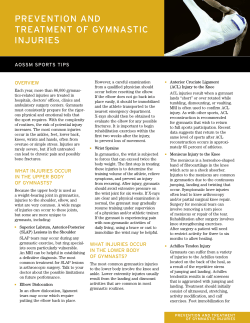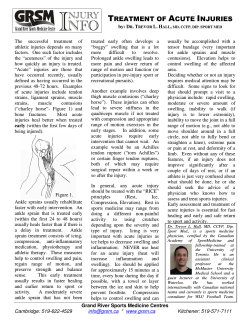
Case report AVULSION OF THE ISCHIAL TUBEROSITY IN A YOUNG
Journal of Sports Science and Medicine (2002) 1, 27-30 http://www.jssm.org Case report AVULSION OF THE ISCHIAL TUBEROSITY IN A YOUNG SOCCER PLAYER: SIX YEARS FOLLOW-UP Bedrettin Akova! ! and Ertan Okay Department of Sports Medicine, Medical Faculty of Uludağ University, 16059 Bursa, Turkey Received: 15 January 2002 / Accepted: 26 February 2002 / Published (online): 20 March 2002 ABSTRACT In this case a seventeen-years-old male soccer player, who sustained an injury while playing football, diagnosed as ischial tuberosity avulsion was reported. Following six-months of a conservative rehabilitation program, the athlete returned to his sports’ activities. Six years along he had no complaints and his athletic performance was not deteriorated. In this case report diagnosis, treatment and six-years follow-up results were discussed. KEY WORDS: Apophysis, avulsion, ischial tuberosity, soccer. GENÇ BİR FUTBOLCUDA TUBER İSKİUM AVÜLZİYONU: 6 YILLIK TAKİP SONUCU ÖZET Bu olgu sunumda, bir futbol maçı sırasında yaralanan ve tuber iskium avülziyonu saptanan onyedi yasında erkek bir futbolcu ele alınmıştır. Konservatif bir tedavi programı uygulanan sporcu 6 ay sonra sportif aktivitesine geri dönmüş ve 6 yıl süre ile sorunsuz bir şekilde performansını devam ettirmiştir. Bu sunumda olgunun tanı, tedavi ve 6. yıl takip sonuçları tartışılmıştır. ANAHTAR KELİMELER: Apofiz, avülziyon, tuber iskium , futbol INTRODUCTION Ischial tuberosity pain in athletes might be caused by several clinical entities, such as acute and chronic bony or periosteal avulsions and apophysitis (Kujala and Orava, 1993; Kujala et al., 1997). These types of injuries, especially in young athletes, were as a consequence of forces exerted by sudden, violent muscular contractions across open apophyses (Boyd et al., 1997; Kujala and Orava, 1993; Schneider et al., 1976). Individuals those aged 17 to 18 years had the highest risk of avulsions (Kujala and Orava, 1993; Stevens et al., 1999) and they were often diagnosed as musculotendinous injury (Boyd et al. 1997, Miller et al. 1987, Poulsen and Enggaard, 1995). CASE REPORT A 17 years-old male soccer player participating in both national youth team and a premier league team referred to our department with the complaint of pain in his left hip and posterior aspect of his thigh. He had been complaining from the pain for 4 months while he was kicking the ball with his leg in extremely abducted position. The team physician had treated him with the diagnosis of muscle strain. He had returned to his sports’ activities after a week of rest since his complaints were mostly relieved. However, two months after the injury he had noted a severe pain in his left hip and posterior aspect of his thigh when he was kicking the ball. Following MRI evaluation, which was demonstrating the areas of edema and hemorrhage in obturator internus, quadratus femoris and adductor magnus muscles and posttraumatic edema of ischial tuberosity (Figure 1 and Figure 2), the patient was referred to our department with the provisional diagnosis of muscle injury in chronic phase. Physical examination revealed prominent tenderness over left ischial tuberosity and the patient had pain with active hip extension and adduction. He 28 Avulsion of Ischial Tuberosity also noted the pain on his thigh radiating from hip with straight leg raising test at 70° of hip flexion. There was not atrophy for thigh muscles. The results of neurological examination were normal. When the MRI was interpreted again, the coronal T2 weighed fast spin echo image revealed the displacement of left ischial apophysis inferiorly and laterally with the hamstring tendons as well as the findings of muscle injury (Figure 1). The displacement of left ischial apophysis compared to right was also shown by sagittal T2 weighed spin echo image (Figure 2). There upon, pelvis plain xray was taken. The x-ray revealed a fragment inferior and lateral to the ischial tuberosity indicating the diagnosis of avulsion of ischial tuberosity (Figure 3). There was irregularity along the ischial tuberosity margins in US and the hyperechoic regions in peripheral soft tissue were interpreted as myositis ossificans (Figure 4). Figure 3. Anteroposterior pelvis x-ray showing avulsion of ischial tuberosity and the fragment is displaced both inferiorly and laterally. Figure 1. Findings consistent with chronic strain in obturator internus, quadratus femoris in coronal T2 weighed fast spin echo image (white arrows). Left apophysis is displaced inferiorly and laterally with the hamstring tendons (black arrow). Figure 2. Sagittal T2 weighed spin echo image showing displacement of left ischial apophysis (black arrow). Chronic strain in adductor magnus muscle (white arrow). Figure 4. US demonstrating irregularity along the margins of ischial tuberosity. Hyperechoic regions in peripheral soft tissue interpreted as myositis ossificans (black arrow). The patient was treated with a conservative rehabilitation program since the displacement of the avulsion was not more than 2 cm. The patient was involved in a 5-graded rehabilitation program described by Metzmaker and Pappas (1985). According to this program he was not permitted to participate sports activities for 2 months. In the first phase (0-7 days) the patient received non-steroid anti-inflammatory medication and physical therapy including hip range of motion exercises, ultrasound, and electrotherapy. Athletic activity was not permitted. In the second stage (7-20 days), isometric, stretching and theraband exercises for hip joint muscles, and light endurance exercises (jogging) were used. In the third phase a guided resistance exercise program was added to the treatment. Approximately 1 month later limited athletic activity was allowed and musclestrengthening exercises were continued. After 2 Akova and Okay months he had no complaints and the physical examination revealed the absence of local tenderness by palpation. Hip ranges of motion were normal and painless. The sagittal bony window CT scan demonstrated a fragment displaced inferiorly and laterally, and heterotrophic bone formation areas in surrounding muscle tissue (Figure 5). With these findings the patient gradually returned back to his activities, and he achieved his ex-performance at six months. 29 Dragoni, 2001). MRI also was used widely for evaluation of these type of injuries, particularly, in the last 10 years (Boyd et al., 1997). CT was rather suggested for chronic cases and for their follow-up (Stevens et al., 1999). Figure 6. Anteroposterior pelvis x-ray showing the avulsive fragment with excessive bone formation resembling a tumoral growth. Heterotrophic ossification areas surrounded the peripheral tissues. Figure 5. Sagittal bony window CT scan showing a fragment (avulsed apophyse) displaced inferiorly and laterally (white arrow). Heterotrophic ossification areas in surrounding muscle tissue (black arrow). The player was re-evaluated six years after the injury. The player did not have any deterioration of performance and was playing soccer in the first division team. He had no complaints and physical examination was normal. The control x-ray (Figure 6) and sagittal bony window CT scan (Figure 7) demonstrated separated fragment, which had excessive bony formation resembling a tumoral growth, and heterotrophic ossification areas in surrounding peripheral tissues. The CT scan also revealed secondary sclerotic changes in inferior ramus of pubis compared to other side. DISCUSSION Figure 7. Sagittal bony window CT scan showing the excessive bone formation of avulsive fragment and heterotrophic ossification areas surrounding the tissues (gray arrow). Secondary sclerotic changes in inferior ramus of pubis due to old trauma (black arrow). Apophyseal avulsions in pelvic region of adolescents usually involve ischial tuberosity and these injuries are particularly seen in soccer players and those dealing with gymnastics (Rossi and Dragoni, 2001). However, the ischial apophyseal injuries were usually diagnosed as muscle injuries as seen in the presented case (Boyd et al., 1997; Kujala et al., 1997). A detailed history of injury and x-ray were very helpful in accurate and early diagnosis of ischial apophyseal injuries (Boyd et al., 1997; Kujala and Orava, 1993; Kujala et al., 1997; Rossi and There was prominent bone reaction at the site of injury in chronic avulsions as seen in the presented case (Kujala et al., 1997; Stevens et al., 1999). Heterotrophic bone formations generally accompanied the healing process and it looked like a tumoral growth (Kujala and Orava, 1993). Muscle weakness, the pain in thigh and sitting difficulty were the problems sometimes encountered with these chronic changes (Kujala et al., 1997; Wootton et al., 1990). The sciatic nerve irritation and related complications might arise (Kujala and Orava, 1993; 30 Avulsion of Ischial Tuberosity Miller et al., 1987). It was noteworthy that no complications indicated above were encountered in our case despite the observed chronic changes. Amount of displacement of ischial apophyseal avulsion was important for deciding the type of treatment. It has been pointed out that the conservative treatment was adequate in avulsions with less than 2 cm displacement (Boyd et al., 1997; Kujala and Orava, 1993; Kujala et al., 1997). The results of the presented case determined 6 years after the injury showed that the conservative rehabilitation was an adequate treatment for similar cases. CONCLUSION A detailed history and x-ray were important for the diagnosis of avulsion injuries involving ischial tuberosities. The conservative treatment program was adequate for these type of injuries without prominent displacement. REFERENCES Boyd, K.T., Peirce, N.S., and Batt, M.E. (1997) Common hip injuries in sport. Sports Medicine 24, 273-288. Kujala, U.M., and Orava, S. (1993) Ischial apophysis injuries in athletes. Sports Medicine 16, 290-294. Kujala, U.M., Orava, S., Karpakka, J., Leppävuori, J., and Mattila, K. (1997) Ischial tuberosity apophysitis and avulsion among athletes. International Journal of Sports Medicine 18, 149-155. Metzmaker, J., and Pappas, A. (1985) Avulsion fractures of the pelvis. American Journal of Sports Medicine 13, 349-358. Miller, A., Stedman, G.H., Beisaw, N.E., and Gross, P.T. (1987) Sciatica caused by an avulsion fracture of the tuber iskiumy. A Case Report. Journal of Bone and Joint Surgery (Am) 69-A, 143-145. Poulsen, T.K., and Enggaard, T.P. (1995) Avulsion fracture of the tuber iskium. A rare lesion whose early diagnosis and correct treatment may prevent late sequelae. Ugeskr Laeger 157, 6140-6141. Rossi, F., and Dragoni, S. (2001) Acute avulsion fractures of thepelvis in adolescent competitive athletes: prevalance, location and sports distribution of 203 cases collected. Skeletal Radiology 30, 127-131. Schneider, R., Kaye, J.J., and Ghelman, B. (1976) Adductor avulsive injuries near the symphisis pubis. Radiology 120, 567-569. Stevens, M.A., El-Khoury, G.Y., Kathol, M.H., Brandser, E.A., and Chow, S. (1999) Imaging features of avulsion injuries. Radiographics 19, 655-672. Wootton, J.R., Cross, M.J., and Holt, K.W.G. (1990) Avulsion of the ischial apophysis. The case for open reduction and internal fixation. Journal of Bone and Joint Surgery [Br] 72-B, 625-627. AUTHORS BIOGRAPHY: Bedrettin AKOVA Employment: Physician, Departmet of Sport Medicine, Univ. of Uludag , TUR Degrees: MD, Univ. of Uludag , TUR, 1993. Specialization, Univ. of Uludag, TUR, 1998. Ass. Prof., 2000. Research interests: Sports-related knee injuries, exercise and oxidative stress, athletic heart. E-mail: bakova@uludag.edu.tr Ertan OKAY Employment: Radiologist,MARTIP,Radiological Imaging Center, BURSA,TUR Degrees: MD, Univ. of Istanbul, TUR, 1990. Specialization, Univ. of Uludag, BURSA, TUR, 1996. Research interest: Radiological imaging of musculoskeletal injuries. E-mail: ertan@martip.com.tr ! Bedrettin Akova, MD, Ass. Prof. Department of Sports Medicine, Medical Faculty of Uludağ University, 16059 Bursa, Turkey
© Copyright 2025











